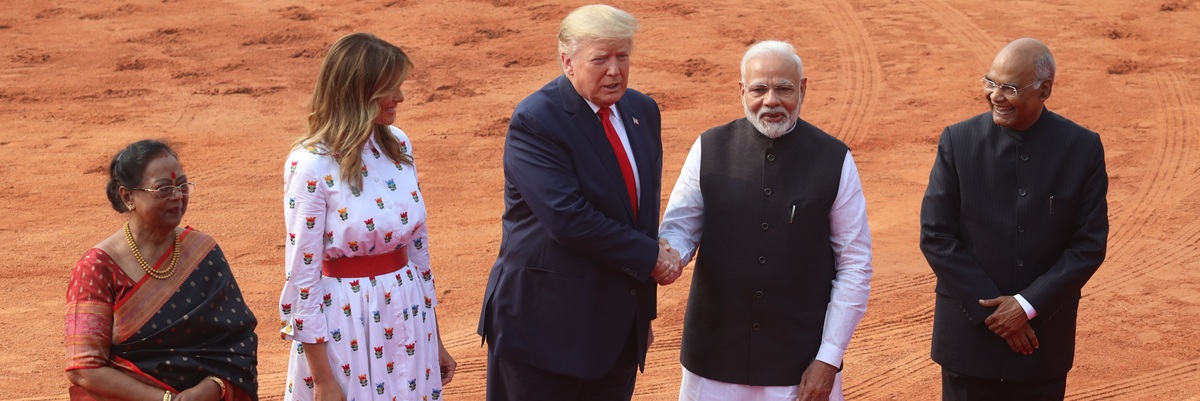Energy & Economics
Trump's tariffs: an economic windfall for India

Image Source : Shutterstock
Subscribe to our weekly newsletters for free
If you want to subscribe to World & New World Newsletter, please enter
your e-mail
Energy & Economics

Image Source : Shutterstock
First Published in: Apr.14,2025
Apr.21, 2025
US tariffs on Indian goods will rise from 17% in 2023 to 26% in 2025. Yet the world's most populated country can see this aggressive US policy as an economic boon for three reasons: its low level of integration into the global market, its ‘Atmanirbhar Bharat’ policy of strategic autonomy and its position as an alternative to China.
The United States is India's biggest customer. It accounts for 19% of India's exports. India considered itself relatively unaffected by the new US customs policy unveiled on April 2. US tariffs on Indian goods will rise from 17% in 2023 to 26% in 2025, if President Trump does not postpone the implementation date once again...
This 26% figure is much lower than the duties imposed on other South-East Asian nations, which to some extent compete with Indian industry. Bangladesh, for example, has tariffs of 37%, Vietnam 46% and Thailand 36%. Certain key sectors of Indian industry, such as pharmaceuticals, are even exempt from additional duties. This exemption underlines the strategic importance of India's exports of generic medicines to the United States. A variable geometry customs strategy.
India, which has no plans to retaliate, is confident of concluding a relatively advantageous agreement thanks to the bilateral negotiations that began in February 2025, following Indian Prime Minister Narendra Modi's visit to the United States.
Indian reindustrialisation?
Some see this new customs policy as an opportunity for India to reindustrialise, something it badly needs to boost employment. Over the years, India has lost its comparative advantage in certain sectors to other South and South-East Asian countries such as Bangladesh, Thailand and Vietnam. The latter face customs duties that are higher than India's, and that are rising faster. Is this likely to boost the competitiveness of these Indian industries? However, they would require long-term investment.
India's industrial strategy has preferred to focus on more technologically advanced sectors, by introducing subsidies for the creation of production capacity through the Production Linkes Incentive (PLI) Scheme. The aim is to reduce dependence on imports and boost exports in priority sectors. The semi-conductor sector, for example, has benefited greatly, with the hope, among other things, of turning India into a manufacturing hub for these products. It hopes to attract €27 billion in foreign direct investment (FDI). The task will certainly be made more difficult by the protectionist policies of the United States.
Re-industrialisation in India will require regulatory reforms and investment in infrastructure. Despite the substantial progress made in these areas, more remains to be done. In any case, for US protectionist policy to encourage the development of Indian industry, it would have to be stable, which does not seem to be the primary orientation of the current Trump administration.
Weak integration into world trade
India's participation in world trade in goods is modest given the size of its economy: in 2023, India's market share in world trade was 2%. Despite its growing trade surplus with the United States, India has been relatively unaffected by the rise in tariffs, partly because Indian imports account for only 3% of total US imports.
Its economy, which is very little integrated into global value chains, will de facto be less severely affected by the new US customs policy. Although its economy trades few goods with the rest of the world, India has a comparative advantage in the service sector, which accounts for almost half of its exports of goods and services. Yet services are largely unaffected by tariffs and remain outside the perimeter of the new US policy.
Indian protectionism: "Atmanirbhar Bharat"
The protectionist stance adopted by the United States may reinforce the Indian government's conviction that it is right for its economy to be only marginally integrated into world trade in goods. The Indian economy is not very open and its trade policy has long tended towards protectionism. The latest industrial policy plan, "Atmanirbhar Bharat" ("Self-sufficient India"), aims to promote both exports and the strategic autonomy of the Indian economy in a number of sectors, including pharmaceuticals, solar energy and electronics.
Since the ‘Made in India’ programme, India's industrial policy has not sought to create growth through exports, but to attract foreign capital to create production capacity in India, mainly for the Indian market. Foreign direct investment (FDI) has risen sharply, albeit from a relatively low base: it stood at 45.15 billion dollars in 2013. By 2022, it will have risen to $83.6 billion.
India, more than ever courted
India is strengthening its strategic position on the international stage. Its economy was already attracting the attention of investors, thanks to its potential market of 1.4 billion consumers and its position as Asia's alternative to China. The erratic behaviour of the Trump administration makes any partnership with India even more desirable, particularly for Europeans.
There is no doubt that the trade talks for an agreement between the European Union and India, that began in 2022 and were brought back to the forefront by the visit of the President of the European Commission to New Delhi in February 2025, will take on a new dimension in the eyes of the Europeans. India's current nationalist government has worked hard to ensure that India becomes a pivotal player in the international community. This leading role on the international stage is a significant electoral asset that should strengthen Narendra Modi's influence within the country.
First published in :

Catherine Bros is a development economist, specialising in India. Her research focuses on issues of social identity, conflict, political participation and the labour market.
Unlock articles by signing up or logging in.
Become a member for unrestricted reading!